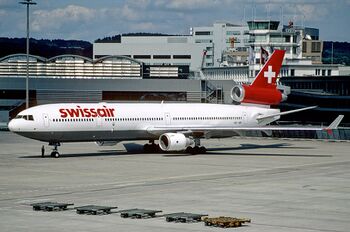Swissair Flight 111
 | |
| Date | 2 September 1998 |
|---|---|
| Location | Atlantic Ocean, near Peggy’s Cove, Canada |
| Deaths | 229 |
| Survivors | 0 |
Swissair Flight 111 was a scheduled international passenger flight from John F. Kennedy International Airport in New York City, United States, to Cointrin International Airport in Geneva, Switzerland. On 2 September 1998 at 01:31:18 UTC, it crashed into the Atlantic Ocean southwest of Halifax Stanfield International Airport at the entrance to St. Margarets Bay, Nova Scotia, Canada. All 229 passengers and crew on board the aircraft were killed.
Cargo and Passengers
Swissair Flight 111 was known as the "UN shuttle" because of its popularity with United Nations officials traveling between the organization's two biggest centers. The flight also carried business executives, scientists, and researchers.
Notable passengers included a Saudi prince, a relative of the former Shah of Persia, a senior UN official, Jonathan Mann, former head of the World Health Organization's AIDS program, and his wife, AIDS researcher Mary Lou Clements-Mann.
The cargo included half a billion dollars worth of diamonds, that were never found.
Official Investigation
The crash investigation cost 57 million Canadian dollars (USD 38 million). 4000 people were involved and it took 4 years. 98 percent of the aircraft was salvaged from the bottom of the sea with great effort and it was reconstructed piece by piece in a hall in order to find the exact cause of the crash.
The investigation carried out by the Transportation Safety Board of Canada (TSB) concluded that flammable material used in the aircraft's structure allowed a fire to spread beyond the control of the crew, resulting in the crash of the aircraft.
The cockpit voice recorder (CVR) and flight data recorder (FDR) were found by the submarine HMCS Okanagan using sonar to detect the underwater locator beacon signals and were quickly retrieved by Canadian Navy divers (the FDR on 6 September and the CVR on 11 September 1998). Both had stopped recording when the aircraft lost electrical power at approximately 10,000 ft (3,000 m), 5 minutes and 37 seconds before impact.
Also, from 20:33 – 20:47 EDT (00:33 to 00:47 UTC), the aircraft experienced a radio blackout for approximately thirteen minutes, which was concluded to be caused by communication radio tuning errors.[1]
Documentary Film
The Canadian broadcaster CBC made a documentary about the crash.
References
- ↑ "Fire on Board". Mayday. Season 1. Episode 3. 2003. Discovery Channel Canada / National Geographic.